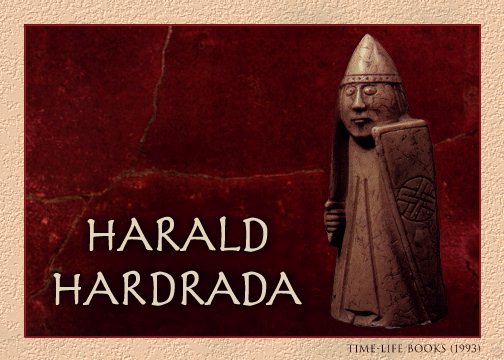
Return to the Battle of Hastings

In the saga of St. Olaf, Snorri Sturluson relates how King Olaf tested his young half brothers. Each of the three were put on his knee. When he angrily glowered at them, the two older boys began to whimper. But Harald, it is said, simply stared back. And when Olaf tugged the boy's hair, he grabbed the king's mustache and pulled it in turn, to which the king remarked "You are likely to be vindictive when you grow up, kinsman."
Another time, Olaf came upon his brothers playing with toy barns and farmhouses, cattle and sheep. Harald, however, played with chips of wood on a pond, pretending that they were his longships. Olaf then asked each what he most would like to have. One boy wanted fields sown with grain; the other, as many cattle as could stand around the pond. But Harald wanted housecarls, as many as could eat all his brother's cows at one time.
Another anecdote occurred just before the battle in which Olaf was killed and Harald wounded.
"'It seems advisable to me,' said the king, 'that my brother Harald be not in this battle as he is still only a child.'
Harold answered, 'By all means I shall take part in it, and if I am so weak as not to be able to wield a sword, then I know what to do: let my hand be tied to the haft.'"
Harald once was asked by Swein Forkbeard what possession he valued the most. He replied that it was his battle standard "Land-Waster" because it prophesied that victory would belong to the one who possessed it. The banner had been with Harald at Stamford Bridge, but Snorri does not say how it foretold victory or defeat.
A passage in the Encomium Emmae Reginae speaks of such a banner. One was carried at the Battle of Ashingdon in 1016, in which the victorious Cnut, in the words of the Chronicler, "won himself all England."
"Now they [the Danes] had a banner of wonderfully strange nature, which though I believe that it may be incredible to the reader, yet since it is true, I will introduce the matter into my true history. For while it was woven of the plainest and whitest silk, and the representation of no figure was inserted into it, in time of war a raven was always seen as if embroidered on it, in the hour of its owners' victory opening its beak, flapping its wings, and restive on its feet, but very subdued and drooping with its whole body when they were defeated."
Edmund Ironside was betrayed at Ashingdon by Earl Eadric Streona, his own brother-in-law, who treacherously had gone over to Cnut the year before. The loss obliged Edmund to conclude a treaty whereby Cnut gained control of Mercia and London, and Edmund retained Wessex. Only months later, however, Edmund died and Cnut succeeded to the whole kingdom.
"Shall you, who have deceived your lord with guile, be capable of being true to me?" asked Cnut of Eadric when he had the traitor's head cut off. The body, says John of Worcester, was thrown from the walls and left unburied.
The chessman pictured above shows the same kite-shaped shield used by the Normans in their conquest of England. One of a hoard found on the Isle of Lewis in the Outer Hebrides, it was carved from walrus ivory when that region still belonged to Norway.